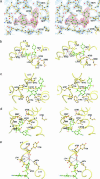Structural basis for antagonism and resistance of bicalutamide in prostate cancer
- PMID: 15833816
- PMCID: PMC1087923
- DOI: 10.1073/pnas.0500381102
Structural basis for antagonism and resistance of bicalutamide in prostate cancer
Abstract
Carcinoma of the prostate is the most commonly diagnosed cancer in men. The current pharmacological treatment of choice for progressive androgen-dependent prostate cancer is the nonsteroidal antiandrogen, bicalutamide, either as monotherapy or with adjuvant castration or luteinizing hormone-releasing hormone superagonists to block the synthesis of endogenous testosterone. To date, no nonsteroidal or antagonist-bound androgen receptor (AR) structure is available. We solved the x-ray crystal structure of the mutant W741L AR ligand-binding domain bound to R-bicalutamide at 1.8-A resolution. This mutation confers agonist activity to bicalutamide and is likely involved in bicalutamide withdrawal syndrome. The three-dimensional structure demonstrates that the B ring of R-bicalutamide in the W741L mutant is accommodated at the location of the indole ring of Trp-741 in the WT AR bound to dihydrotestosterone. Knowledge of the binding mechanism for R-bicalutamide will provide molecular rationale for the development of new antiandrogens and selective AR modulators.
Figures




References
-
- Anonymous (1989) Med. Lett. Drugs Ther. 31, 72 (Clinical trial). - PubMed
-
- Anonymous (1996) Am. J. Health Syst. Pharm. 53, 2784 (News). - PubMed
-
- Kolvenbag, G. J. & Furr, B. J. (1999) Urology 54, 194-197. - PubMed
-
- Kolvenbag, G. J. & Blackledge, G. R. (1996) Urology 47, 70-79, discussion 80-84. - PubMed
-
- Schellhammer, P. F. & Davis, J. W. (2004) Clin. Prostate Cancer 2, 213-219. - PubMed
Publication types
MeSH terms
Substances
Associated data
- Actions
Grants and funding
LinkOut - more resources
Full Text Sources
Other Literature Sources
Medical
Research Materials

